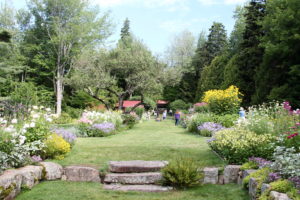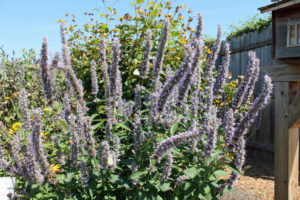The Tricks to a Full-Blooming Perennial Garden
September 12th, 2017
If you’ve ever planted a perennial garden, you probably noticed that it never seems to fire on all cylinders.
Rather than a full mass of color, you usually end up with more of a “symphony” as the different species go in and out of bloom. That’s because most perennials bloom for only four to six weeks of the season, and the spots of color change with the makeup of what you planted.
So how comes the perennial beds at Thuya Gardens near Bar Harbor, Maine, bloom wall to wall?
When our tour group saw this English-style double perennial border at this hilltop garden in mid-August, it appeared that just about everything was in color all at once.
Look closer, though, and you’ll unearth some “tricks” that you might copy at home.
For one thing, not all of Thuya’s flowers were perennial ones. About a third of the choices were annuals – ones that die off each season but that generally bloom non-stop in the meantime.
Mixed in with the perennial coneflowers, lilies, phlox and globe thistle were annual ageratum, nicotiana, dahlias and verbena.
Annuals are useful not only for creating fullness in the gaps among the perennial clumps, but their continuous flowering bridges color gaps as the various perennials bloom and fade.
What made Thuya’s planting especially nice is that the gardeners color-coordinated and form-contrasted the particular annuals with their perennial neighbors.
For instance, short blue annual ageratums paired with tall rosy-pink lilies, and tall, lacy-leafed, pale-pink annual cleome towered over dwarf, white, wider-leafed perennial coneflowers.
No random placement here.
That’s the kind of artistry that makes gardening such a creative experience – and is the subtle explanation that separates “nice” gardens from truly impressive ones.
Another trick is that Thuya Gardens are loaded with summer-blooming perennials.
Since this is a garden that visitors mainly see in June, July and August, Thuya purposely stacked the plant selection with perennials that bloom in those three months.
Instead of allocating space to early bloomers such as candytuft, bleeding heart and creeping phlox or to late bloomers such as mums, asters and Montauk daisies that’ll bloom after the crowds are gone, all of the garden space is devoted to summer bloomers.
That can make sense at home, too, depending on when you’re there and what you’re trying to achieve.
Example 1: Some people overwinter in Florida and don’t get back until April. So in those gardens, it makes sense to skip snowdrops, helleborus, crocuses and other plants that are going to be bloomed out by early April in favor of summer and early-fall bloomers.
Example 2: Some people spend a lot of time in summer at the beach or traveling north, so they’re not around to see mid-summer bloomers. In those gardens, it might make sense to load the perennial beds on the shoulder seasons of spring and fall.
Example 3: Some people just like full-blooming gardens. So rather than plant perennial gardens with the mix of different-season bloomers that’s usually recommended to “spread out the color,” Thuya’s approach can be copied by creating, say, a spring-peaking perennial garden in one area, a summer-peaking perennial garden in another area, and a fall-peaking perennial garden in a third area.
A third trick to a full-blooming perennial garden is to pick perennial varieties that bloom as long as possible.
That’s a main goal of perennial-plant breeders, and they’ve succeeded in developing plenty of new varieties in the last 20 years that bloom for months instead of weeks.
Some of the longest choices include hardy geranium, dwarf catmint, Russian sage, agastache, and gaura.
See George’s list of 12 Top Perennials that Bloom a Long Time
Deadheading – the practice of snipping off spent flower heads – also encourages longer bloom. That prevents flowers from going to seed and “thinking” they’ve accomplished their procreation mission for the year.
Many other perennials rebloom – especially if you cut them back hard after the first bloom. Salvia, catmint, coreopsis and many daylilies fall into that category.
Finally, Thuya uses foliage color to finish off their fullness trickery.
Dark-leafed coralbells, burgundy-leafed alternanthera, and silver-leafed artemisia are among the many perennials that give season-long color from their leaves. That makes them as valuable as annuals and turns the flowers into a bonus.
Maybe you already have the lineup of plants to do what Thuya is doing; it might just take a little rearranging to move to the next level.
Or maybe you’re partway there and just need a few more selected perennials to get the job done.
Either way, now through the end of October is an ideal time to plant and transplant.
You can worry about plugging in the annuals next May.










